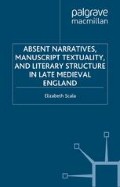Abstract
The primary function of the medievalist is to locate missing stories. Lost manuscripts, anterior sources, and earlier textual versions structure the way we think about the literature of the Middle Ages. Medieval literary works always bear witness to an other text, most often figured materially as the textual ancestor from which it has been copied. Such ancestral others—others that are typically imagined as the medieval exemplars of our final copytexts—are not the only texts lurking behind modern print. Sometimes the work remains other to itself and must be (re)assembled from the various and sometimes corrupted manuscript versions and early printed editions that have survived.
Access this chapter
Tax calculation will be finalised at checkout
Purchases are for personal use only
Preview
Unable to display preview. Download preview PDF.
Copyright information
© 2002 Elizabeth Scala
About this chapter
Cite this chapter
Scala, E. (2002). Introduction Absent Narratives and the Textual Culture of the Late Middle Ages. In: Absent Narratives, Manuscript Textuality, and Literary Structure in Late Medieval England. The New Middle Ages. Palgrave Macmillan, New York. https://doi.org/10.1057/9780230107564_1
Download citation
DOI: https://doi.org/10.1057/9780230107564_1
Publisher Name: Palgrave Macmillan, New York
Print ISBN: 978-1-349-38727-4
Online ISBN: 978-0-230-10756-4
eBook Packages: Palgrave Literature & Performing Arts CollectionLiterature, Cultural and Media Studies (R0)

